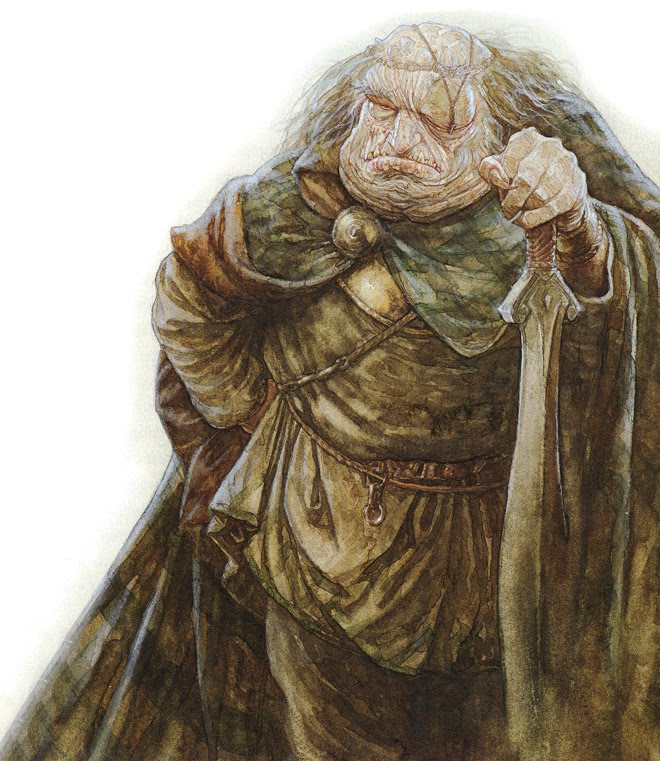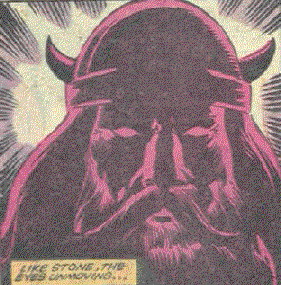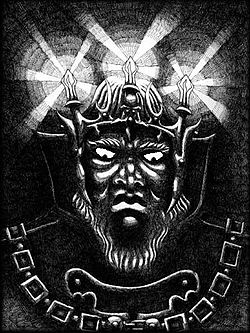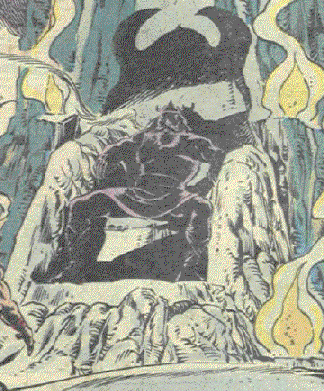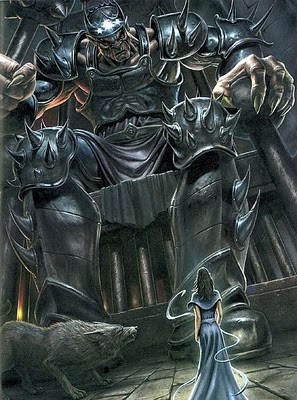"Mad" Elves and "elusive beauty": some Celtic strands of Tolkien's mythology
https://web.archive.org/web/2016032...009/09/mad-elves-and-elusive-beauty-some.html
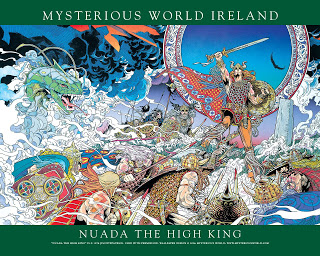
[1]
Folklore, August, 2006
by Dimitra FimiAbstract
Contrary to Tolkien's refutation of "Celtic things" as a source for his own mythology, this article attempts to show how his work has been inspired by Celtic folklore and myth. The article is not just a source study. It concentrates on one main example from Tolkien's early literary writings that betrays a Celtic influence. At the same time it discusses Tolkien's complex attitude towards "things Celtic" within the context of his strong sense of English identity. Finally, it seeks to explain Tolkien's derogatory comments on Celtic material as a result of popular ideas of "Celticity."
IntroductionIn November 1937, after the success of The Hobbit, Tolkien sent to his publishers "The Silmarillion," [2] the myths and legends of the Elves that he had been working on for years, with a possible view to publication. In turn, they passed the manuscript to one of the firm's outside readers, Edward Crankshaw, for evaluation. He reported unfavourably on it, part of the reason being its "eyes-plitting Celtic names." He also claimed that "It has something of that mad, bright-eyed beauty that perplexes all Anglo-Saxons in face of Celtic art" (Carpenter 1981, 27). Tolkien's response to his publishers shows that he was rather annoyed by such a characterisation of his work. He defended his nomenclature, by saying: "I am sorry the names split his eyes--personally I believe ... they are good, and a large part of the effect." He also added quite angrily:
Needless to say they are not Celtic! Neither are the tales. I do
know Celtic things (many in their original languages Irish and
Welsh), and feel for them a certain distaste: largely for their
fundamental unreason. They have bright colour, but are like a
broken stained glass window reassembled without design. They are in
fact 'mad' as your reader says--but I don't believe I am
(Carpenter 1981, 26).
Tolkien's reaction to "things Celtic" being identified as possible sources for his own mythology seems rather over-emotional. In another letter written almost twenty years later, however, Tolkien commented on his "invented language" for the Grey Elves, namely Sindarin (the Elvish language most prominently featuring in The Lord of the Rings), and explained how it was "deliberately devised to give it a linguistic character very like (though not identical with) British-Welsh." He added that one of the reasons for modelling this language upon Welsh was "because it seems to fit the rather 'Celtic' type of legends and stories told of its speakers" (Carpenter 1981, 176).
These two contradictory statements seem to summarise Tolkien's complex attitude towards things Celtic. His strong refutation of Celtic material as a source of, or influence on, his literature might not appear to be so strange if one takes into account his own special area of academic expertise, and his character and "mission" as a writer. Tolkien was an expert on Anglo-Saxon philology, with a strong sense of English identity that he often associated with Britain's Anglo-Saxon past. At the same time he had started writing his stories of the Elves in an effort to create a "mythology for England," England being understood as opposed to Britain. On the other hand, however, as the letter to his publishers quoted earlier also suggests, Tolkien was far from ignorant about "things Celtic" and he later described his stories of the Grey Elves as being of a "Celtic type." This love-hate relationship with "things Celtic" has made Tolkien's mythology of Middle-earth more complex and more attractive.
"I do know Celtic things": Tolkien and Celtic Studies
Tolkien had nourished an attraction for the Welsh language and a fascination with the stories of King Arthur since childhood. It might have been his school friend G. B. Smith, however, an admirer of the "Mabinogion" and of the Arthurian legend--particularly its Welsh origins--who triggered his interest in "things Celtic" in a more general sense.
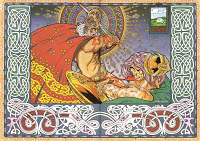
Tolkien's first copy of Pedeir Keinc y Mabinogi was bequeathed to him by Smith, who died in the Great War (Garth 2003, 236). During the period 1920-25 Tolkien and his colleague E. V. Gordon worked on the edition of the Middle English poem Sir Gawain and the Green Knight, which was finally published in 1925. The editing of Sir Gawain must have enhanced Tolkien's interest in Celtic studies, since--according to the fashion of the time--it included in its introduction an elaborate tracing of the Arthurian story to its older analogues in French as well as in Celtic material (Tolkien and Gordon 1925, xi-xvii).
During the 1930s, Tolkien wrote an appendix for the report on the excavation of the Lydney Park Site, in Gloucestershire. The appendix concerned the name "Nodens," found in inscriptions at the site, revealing the cult of a Celtic god in the post-Roman and pre-Anglo-Saxon period. Tolkien analysed the name in detail in terms of its philological, mythological and literary connotations, and attempted to reconstruct the "image" of the god, mainly by associating him with the Irish deity Nuadu (Tolkien 1932). Finally, Tolkien had at least an awareness of contemporary Celtic folklore, especially the fairy lore of Ireland and Wales. In his writings he has referred to the "daoine-sithe," or Shee-folk, and the "tylwyth teg," which he rendered as "Fair Family" and "beautiful kindred" (Tolkien 1983a, 111 and 113; 1975, 165).
In terms of the Celtic languages, Tolkien's knowledge and appreciation for Welsh is well known. He had famously said in an interview:
Welsh has always attracted me, in sight and sound more than any
other, even since the first time I saw it on coal trucks, I always
wanted to know what it was about ... (Tolkien 1965). [3]
As an undergraduate in Oxford, Tolkien was urged by the renowned Germanic philologist Joseph Wright to "go in for Celtic, lad; there's money in it." He did not become a Celtic philologist, but he ended up spending all the money of the only prize he ever won while in Oxford to buy the Welsh Grammar of Sir John Morris-Jones (1913), and started studying the language on his own (Tolkien 1983a, 192; Carpenter 1981, 320 and 250). He never learned modern Welsh well enough to be able to speak it, but his knowledge of medieval Welsh was such that he was able to teach it and to read parts of the "Mabinogion" in the original (Carpenter 1981, 12-13). Tolkien was also the first speaker of the prestigious O'Donnell lectures, which were established to discuss the Celtic element in the English language, in which he enthusiastically declared that "Welsh is beautiful," and he revealed those sounds of the Welsh language that attracted him most (Tolkien 1983a, 189-94). The main way in which Welsh affected Tolkien's work was the use of its phonetic structure to create one of his invented languages, the language of the Grey-elves, Sindarin. Tolkien seems, however, to have struggled hard with Irish, which he never succeeded in mastering, which is probably the reason why he declared the Irish language to be "wholly unattractive" (Carpenter 1981, 289, 385 and 134).
Tolkien's interest in, and engagement with, Celtic studies sometimes went beyond what would be expected of an Oxford don specialising in Old English. Especially when it comes to the Celtic archaeology publication mentioned earlier, one could reasonably ask why a Professor of Anglo-Saxon was asked to contribute to it and not, for example, John Fraser, the Jesus Professor of Celtic in Oxford during that period. This involvement with "Celtic things" demonstrates, then, an individual, personal interest of Tolkien's in Celtic studies. In his unfinished work "The Notion Club Papers," written during 1945-6 and published posthumously in the ninth volume of the History of Middle-earth series, we find Professor Michael George Ramer, who is a:
Professor of Finno-Ugric Philology; but better known as a writer of
romances. His parents returned to England when he was four; but he
spent a good deal of time in Finland and Hungary between 1956 and
1968. [Among his interests are Celtic languages and antiquities]
(Tolkien 1992, 159).
This character echoes Tolkien's self in many respects: his specialty in philology (although here it is Finno-Ugric, a family of languages that produced Finnish that Tolkien admired and used in Quenya, the other main Elvish language he created), his having been born abroad and returning to England when very young--exactly like Tolkien--and his being more famous as a writer of romances than as an academic, again very like Tolkien himself. The not-too-obvious link is the "interest in Celtic languages and antiquities," which, however, sounds much more convincing if one takes into account Tolkien's involvement with Celtic archaeology. Indeed, when at some point Tolkien had certain members of the Inklings in mind as "models" for the characters in "The Notion Club Papers," he tentatively identified Ramer with himself (Shippey 1992, 150).
Finally, apart from his literature associated with the Middle-earth saga, Tolkien also wrote a poem and two unfinished works on Celtic subject matter. He started writing all three of these during the 1930s. The first one, which was finally finished and published much later in the Welsh Review, is "The Lay of Aotrou and Itroun," a poem inspired by the folklore of Brittany, having as one of its main characters a Corrigan (Tolkien 1945). The two unfinished works are "The Fall of Arthur" and "The King of the Green Dozen." The former is described by Carpenter as Tolkien's own version of the Morte d'Arthur, in which "the king and Gawain go to war in 'Saxon lands' but are summoned home by news of Mordred's treachery" (Carpenter 1977, 168). Tolkien refers to the latter work, "The King of the Green Dozen," in a letter written in 1938, where he describes it as "an unfinished pseudo-Celtic fairy-story of a mildly satirical order" (Carpenter 1981, 40). The editorial notes to the letter add that the story, which is set in Wales and "parodies the 'high' style of narrative," is about the King of Iwerddon "whose hair and the hair of his descendant's twelve sons is coloured green" (Carpenter 1981, 436).
The "Soil of Britain": English versus Celtic Identity
As already mentioned briefly, Tolkien's reaction to "things Celtic" might have something to do with the contrast of English and British identities in his writing. Tolkien's early nationalistic project to create "a mythology for England," [4] and thus restore the reputation of his country, which lacked a proper mythology, is familiar to Tolkien scholars. In a much later letter to Milton Waldman he expressed this early plan of his by writing:
I was from early days grieved by the poverty of my own beloved
country: it had no stories of its own (bound up with its tongue
and soil) ... There was Greek, and Celtic, and Romance, Germanic,
Scandinavian, and Finnish ... but nothing English, save
impoverished chap-book stuff. Of course there was and is the
Arthurian world, but powerful as it is, it is imperfectly
naturalized, associated with the soil of Britain but not with
English; and does not replace what I felt to be missing ... Do
not laugh! But once upon a time ... I had in mind to make a body of
more or less connected legend, ranging from the large and
cosmogonic, to the level of romantic fairy-story ... which I would
dedicate simply to: to England; to my country ... The cycle should
be linked to a majestic whole, and yet leave scope for other minds
and hands, wielding paint and music and drama (Carpenter 1981, 144).
Tom Shippey has demonstrated brilliantly how Tolkien's early plan to create a national mythology for England fits in with nineteenth-century "reconstructions" of other Northern European mythologies for similar nationalistic projects, such as the Grimm brothers' collection of fairy-tales in Germany and Jacob Grimm's Deutsche Mythologie, the efforts of Nikolai and Sven Grundtvig to revive the Danish ballads, and, most importantly, Elias Lonnrot's creation of a Finnish national epic, the Kalevala (Shippey 2001, x-xvi; 2002). In the case of England, however, the question of national identity is far more complicated than the rest of Northern Europe.
A British "national identity" emerged during the eighteenth and nineteenth centuries, which included Scotland and Wales and, from the nineteenth century, Ireland. This was mainly due to the formation and successful expansion of the British Empire, which reached its climax during these years (Colley 1992, 144; Kumar 2003, 170-2). Of course, in the "Celtic" parts of Britain a sense of separate national and cultural heritage was maintained, but since the dominant and leading role of the English in the creation and maintenance of the Empire was never challenged or contested until the Irish successfully did so in the early twentieth century, there was no need for a specifically English national identity to emerge (Colley 1992, 53; Kumar 2003, 156 and 79). It has been argued, however, that there was a moment of pure English nationalism, which was milder than the equivalent ones of the rest of Europe, but was still based on the same principles: association of the modern nation with its glorious past, and praise of its primeval virtues (Kumar 2003, 202-17). This was the "invention" of Anglo-Saxonism, a movement that would refer to the "Golden Age" of the Anglo-Saxons before the Norman invasion, a period when the true English spirit of freedom and democratic institutions was still alive and thriving (Horsman 1976; Melman 1991; Kumar 2003, 204-7). It was mainly during the end of the nineteenth century and the beginning of the twentieth that Anglo-Saxonism became a national myth (Melman 1991, 578-9), and it is not at all accidental that this happened during a period when the British Empire was slowly starting to move towards the stage of decline.
Tolkien was not immune to the Anglo-Saxon pride syndrome. He was proud to be an Anglo-Saxon by descent and a student of his ancestors' noble language (Carpenter 1981, 56, 102, 108 and 340). Thus, his attempt to create an English mythology can be interpreted and justified. He started writing at a time when the Anglo-Saxons had been rediscovered and praised as the ancestors of modern England. He found scant mythological material from the literature of this "great people," however, in contrast with the Welsh, Scots, and Irish, who already had an established "Celtic" heritage and mythology. Indeed, it seems that the rising Welsh and Scottish cultural nationalism during the same period was an additional provocation that made English nationalism necessary (Kumar 2003, 200). Tolkien felt the lack of a mythology as an important deficiency for his own country and its national identity, and what he set out to do is exactly what Elias Lonnrot had done before in Finland--he undertook the task of the middle-class intellectual to provide his country with a mythology.
Advertisement
The much quoted statement of Tolkien's mentioned earlier is very significant for the Celtic versus English contrast in his early work. Tolkien did not equate "the land of Britain" with "the land of England." Nowadays, the term "Celtic" itself has been called into question, but in Tolkien's time the early history of Britain was seen as a succession of invasions, including that of the Celts (who were romanticised and considered as a coherent people with a common language and culture), followed by the Anglo-Saxons later on. [5] For Tolkien, the Anglo-Saxons were the true ancestors of the English and he was as much opposed to the cultural heritage of the Celts as to that of the Normans. This is why he also thought that the Arthurian cycle did not qualify for the title of "English mythology": it was not just its use by the Normans and its French sources, but its ultimate origin in Welsh legend and myth, rather than in Anglo-Saxon culture. Indeed, in "The Book of Lost Tales," which is the earliest form of what today we know as The Silmarillion, his mythology is firmly associated with England's Anglo-Saxon past.
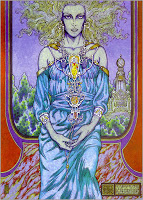
In "The Book of Lost Tales," one of the main characters, a traveller to the Island of the Elves, who later reports the true tradition of the Elves to Men, is a fictional Anglo-Saxon. In the earlier version his name is Eriol, he comes from the lands whence the Anglo-Saxons came to England. Later, his sons Hengest, Horsa and Heorrenda conquer the island, and befriend the Elves, and the island becomes England (Tolkien 1984, 278-94). In the second version he is called AElfwine. He is an Anglo-Saxon of eleventh-century Wessex, sailing from England to the island of the Elves (in some versions he is even driven by the Norman Yoke). He finds out that the Elves used to inhabit England but left it because of their longing for the West, and they still speak the Old English language (Tolkien 1984, 300-10). [6] Central to the whole conception is the contrast between the English and Celtic tradition, and Eriol/AElfwine is a key character in this antagonistic attitude, since Tolkien claims that it is from him that "the Engle (English) have the true tradition of the fairies, of whom the Iras (Irish) and the Wealas (Welsh) tell garbled things" (Tolkien 1984, 290). Thus, he distinguishes his Elves and fairies from the equivalent creatures found in Celtic mythology, and at the same time claims the true tradition as being exclusively English.
This last statement by Tolkien might also show some anxiety to lay claim to a specifically English fairy lore that was distinct from that of the Irish, who maintained that their fairies were more genuine and rooted in oral tradition. Folklore, and especially that incorporating ideas about the fairy otherworld (the sidhe), played an important role in the Anglo-Irish literary revival of W. B. Yeats, Lady Gregory and others. Purkiss maintains, rightly or wrongly, that the Irish revivalists succeeded in linking the fairies and fairy lore to Irish national and cultural identity to such an extent that "fairies and folklore became an essential part of Irishness" (2000, 294). Yeats defended the authenticity of the Irish fairies against the English ones, claiming that the former were unaffected by literary treatments and romantic interpretations, something that Scott had done nearly a century before for the Scottish fairies; while Chesterton's defensive approach, rebuking Yeats, who "reads into Elfland all the righteous insurrection of his own race" (Beddoe 1997, 31; Chesterton 1908), shows the extent of the national conflict this situation could produce. Bown might not be exaggerating when she commented that at that period "at its most extreme, the dialogue about Irish home rule could become an argument about who had the better fairies: England or Ireland" (2001, 4). Tolkien's reaction to this was to contrast his fairies and those of Celtic tradition sharply, and even to insist upon the authenticity of his own mythology against the Celtic fairy-lore. This attitude of envy towards the Celtic fairies is also present in his later writings, especially in his essay "On Fairy-Stories," where he discusses how the English fairy was heavily influenced by its Celtic and other analogues (Tolkien 1983a, 111).
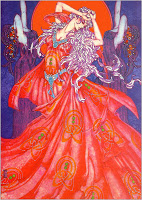
The Earliest Loan: The Story of the Noldor and the Tuatha De Danann
Nonetheless, "things Celtic" still crept into Tolkien's Middle-earth literature, where they were mainly associated with the Elves and Valinor. For anyone familiar with medieval Irish literature, there is a striking similarity between the Noldor, the Elves that rebelled against the Valar and abandoned Valinor to return to Middle-earth, and the Tuatha De Danann, the semi-divine creatures of Irish mythology and ultimately of Irish folklore. Tyler (1976) was probably the first to point out this similarity, but he was writing a popular book and made some errors, interpreting the name Tuatha De Danann as the "People of Don," rather than the accepted "The People of the Goddess Danu" (O hOgain 1990, 296) and stating that the Fir Bolg were the people that finally defeated them, instead of the Sons of Mil (Tyler 1976, 179). [7] Apart from Tyler, Gunnell has also referred epigrammatically to the remarkable parallel between the Tuatha De Danann and Tolkien's Noldor, suggesting that there should be more careful examination of the Irish associations of Tolkien's work (Gunnell 2002).
The story of the Tuatha De Danann is found in the pseudo-historical Lebor Gabdla Erenn ("The Book of Invasions of Ireland"), which recounts the successive invasions of Ireland by different semi-divine or mythical peoples. The Tuatha De Danann are the penultimate invaders before the Sons of Mil, the latter being considered to be the historical ancestors of the Irish people (O hOgain 1990, 296). The story of the invasion of Ireland by the Tuatha De Danann can be summarised as follows. The Tuatha De Danann were the progeny of Neimheadh (one of the previous races that had invaded and occupied Ireland but had eventually fled it) and they came from the northern islands of the world, although in some versions they are said to have come from Greece. It is in these islands that they learned "druidry, and prophecy and magic," and it was not known whether they were really demons or men. They came to Ireland (while fleeing from the Philistines, according to one account) led by their king, Nuadhu, and they demanded from the Fir Bolg (the previous race that had invaded Ireland) a "battle of kingship." One of the versions adds that they were justified in invading Ireland because it was theirs by right of heredity. The manner in which they arrived in Ireland is dealt with in two narratives. The first states that they came in dark clouds through the air "by might of druidry."

The second is a euhemerised version of the first, according to which the Tuatha De Danann arrived in ships, which they subsequently burned. The smoke from the burned ships probably gave rise to the idea that they arrived in clouds.
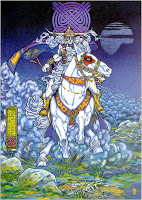
The reason for burning their ships was that they did not want them to be stolen by the Fomheire (another race of "demons" that had been taking over Ireland from time to time). In addition, the Tuatha De Danann did not want to have the option of setting sail from Ireland in the event of their being defeated by the Fir Bolg. After landing in Ireland they caused an eclipse of the sun for three days and nights. Then, the First Battle of Moytirra was fought against the Fir Bolg, during which many of the latter were killed. Although the Tuatha De Danann were victorious, they also suffered many casualties, including the loss of Nuadhu's arm. They then took the kingship of Ireland and when, much later, they were themselves overthrown by the Sons of Mil, they were routed to the sea. [8]
In Tolkien's story of "The Flight of the Noldor" included in The Silmarillion, we see the most gifted of the Elves abandoning the holy island of Valinor, where they had been brought by the Gods and where their intellect and skills had been enriched. They steal the ships of Teleri, by committing the sinful act of kin slaying, and they use them to sail to Middle-earth. They subsequently burn their ships upon arrival to prevent other Elves from following them to Middle-earth, and they fight the Battle-under-Stars against the evil forces, which takes place in starlight since the Sun and Moon have not yet been created by the Gods. Finally, one of their leaders is captured in the battle, and left to be tortured by hanging from his hand, which he finally has to sacrifice in order to be released from captivity (Tolkien 1977, 79-80 and 106-13).
The parallels of these two brief outlines of the invasion of the Tuatha De Danann in Ireland and the arrival of the Noldor in Middle-earth are remarkable. First, the Tuatha De Danann are not clearly defined as "demons" or men, but appear as semi-divine beings. This can be compared with the nature of the Elves, who are inferior to the Valar, the "gods," but superior to men. Significantly, Cross and Slover refer to the Tuatha De Danann as "large, strong, and beautiful beings who mingled with mortals and yet remained superior to them" (1969, 1), a description that could perfectly fit Tolkien's Elves. The Tuatha De Danann are also described as craftsmen, warriors, poets and magicians, and they acquired these skills in the northern islands of the world. This is paralleled by Tolkien's High-Elves, who learn arts and crafts from the Valar while being in Valinor, the island of the "gods" in the West. This is what ultimately differentiates the High-Elves from the Grey Elves, who never saw the light of Valinor. Additionally, as previously mentioned, it is admitted in the "Book of Invasions" that going to Ireland was a right by heredity for the Tuatha De Danann, and the same is also implied by the Noldor's flight to Middle-earth, as, in Feanor's words, they should "return to our home" (Tolkien 1977, 83).
Perhaps the most striking similarity is, however, the burning of the ships of the Tuatha De Danann and the Noldor upon their arrival in Ireland and Middle-earth, respectively. The reason why the Noldor burned their ships is slightly different from that of the Tuatha De Danann. The former burned their ships by Feanor's command, in order not to allow the rest of the Noldor to pass to Middle-earth, thus leaving the domination of the land to Feanor's kindred. The determination of the Tuatha De Danann, however, not to leave Ireland even if defeated by the Fir Bolg corresponds also to the determination of the rest of the Noldor to reach Middle-earth, even by crossing the deadly ices of Helcaraxe (Tolkien 1977, 90). The first battle of Moytirra can be compared with the Battle-under-Stars ("Dagor-nuin-Giliath"), where Feanor's army defeated Morgoth's orcs, while the eclipse of the sun is equivalent to the non-existence of Sun and Moon in Middle-earth until the coming of the rest of the Noldor through the ices, which happened later than the end of the battle (Tolkien 1977, 106 and 108-9). Finally, the loss of Nuadhu's arm in the first battle of Moytirra is paralleled by the loss of Maedhros's hand, which Fingon had to cut above the wrist to release him from Morgoth's prison (Tolkien 1977, 110). Maedhros may not be the original king of the Noldor, but he is the first son of Feanor, and the natural next leader of his kindred.
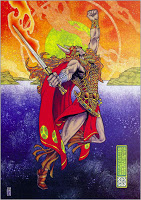
It is not only the invasion and first battle of the Tuatha De Danann in Ireland, however, that can be claimed to be equivalent to the arrival of the Noldor to Middle-earth. The final defeat of the Tuatha De Danann by the Sons of Mil, and their subsequent agreement to go into exile, a number of them across the sea, is also significant. O hOgain refers in detail to the agreement of the Tuatha De Danann to dwell underground, in ancient barrows and cairns, and to their alternative portrayal as living in "idyllic overseas realms, such as Magh Meall (the 'Delightful Plain') or Eamhain Ablach ('the Region of Apples')" (1990, 408-9). This corresponds to the fact that the Elves do return ultimately to Valinor across the sea, the last Elves being engaged in this process towards the end of the plot of The Lord of the Rings. It is also intriguing that the Tuatha De Danann finally came to be transformed into the Irish fairies of folklore in popular imagination (O hOgain 1990, 185; Gunnell 2002), a view also referred to by popular folklorists of the Anglo-Irish revival such as W. B. Yeats (1957, 3). This idea of the old Celtic deities becoming the "little people" of folklore is also reflected in Tolkien's Elves, especially in his early work. In "The Book of Lost Tales," the domination of Men leads to the "fading" of the Elves, and to their becoming diminutive and transparent (Tolkien 1984, 281, 283). This idea seems to be still valid as late as The Lord of the Rings, when Galadriel reflects on the fate of the Elves after the destruction of the one Ring. She tells Frodo that if his mission succeeds, then "our power is diminished, and Lothlorien will fade, and the tides of Time will sweep it away. We must depart into the West, or dwindle to a rustic folk of dell and cave, slowly to forget and to be forgotten" (Tolkien 1993a, 474).
The story of the Noldor as already outlined and as presented in the published Silmarillion went through a few stages before it evolved into that final form. Christopher Tolkien, by undertaking the colossal task of editing and publishing his father's manuscripts concerning his mythology, has given the students of Tolkien's work the opportunity to trace stories and motifs from their first appearance in Tolkien's legendarium until their final development. The story of the rebellion of the Noldor (then called the Gnomes) and their departure from Valinor to return to Middle-earth is already present in "The Book of Lost Tales," the earliest form of the mythology, written between 1916 and 1922, and its main elements are already there: Feanor urges the Gnomes to follow him back to Middle-earth to regain the Silmarils that belong to them, the Sun and the Moon are made by the gods subsequent to their departure, and the Gnomes fight their first battle with the Orcs as soon as they land. In this first version, however, the Gnomes do not use the ships to cross the sea but abandon them, setting fire to some of them, and get to Middle-earth by crossing the ices of Helkarakse (sic), while Maedhros (then spelled Maidros) is captured by Morgoth and sent back maimed, although the nature of his torture and maiming are not described (Tolkien 1983b, 162, 174-95 and 237-8).
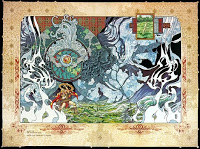
In "The Lay of the Children of Hurin," written between 1920 and 1925, the episode of Maidros's (sic) hanging from his arm and the subsequent loss of his hand was added (Tolkien 1985, 222), while in only one prose fragment written a little later is the burning of the ships explained as the result of the Gnomes' repentance (Tolkien 1986, 9). By the late 1920s, Tolkien had written the earliest "Silmarillion," which he referred to as the "Sketch" of the mythology, where the main elements of the later story appear fully shaped, and only minor details were added to it in later texts (Tolkien 1986, 18, 22-3 and 52). [9]
Apart from these impressive similarities with the history and fate of the Noldor, the Tuatha De Danann and the whole story recounted in "The Book of Invasions" feature elsewhere in Tolkien's legendarium also. In "The Book of Lost Tales," the land of England, called Luthany, a name that Tolkien borrowed from the Catholic mystic poet Francis Thompson, is portrayed as having undergone "the Seven Invasions of Luthany," including such peoples as the "Guiolin," the "Brithonin," the "Rumhoth," the "Ingwaiwar," and the "Forodwaith." The last three peoples can be securely identified as the Romans, the Anglo-Saxons, and the Vikings, respectively (Tolkien 1984, 294 and 323), while the name "Brithonin" sounds suspiciously close to "British," very possibly alluding to the British-Celts that invaded Britain before the Romans and the Anglo-Saxons. Also, the term "Guiolin" brings to mind the Welsh word for the Irish ("Gwyddel") and might imply the infrequent raids on Britain by Irish looters. So, by using the framework of the "Book of Invasions" Tolkien constructs a pseudo-history of England, which corresponds vaguely to the real historical invasions of the island, in the same way that "The Book of Invasions" creates a mythological history for Ireland. It should also be remembered that scholars tended to attribute some historicity to the "Book of Invasions" at least up until the end of the nineteenth century, attempting to identify the mythical races that came to Ireland with specific historical invaders of the island.
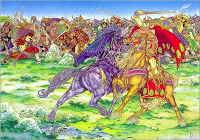
A "Magic Bag": Romancing "Celticity"
Despite Tolkien's strong declarations against Celtic influences in his work in his 1937 letter to his publishers quoted earlier, he had by that time already used the story of the Tuatha De Danann in his mythology. If one reconsiders Tolkien's main objections to "things Celtic" in that letter, two major points of disapproval seem to prevail: incoherence and bright colour. Tolkien talked about the "unreason" and lack of "design" of the Celtic sources, and referred to them as "broken." This view had already been expressed in more scholarly terms in the introduction to his and Gordon's edition of Sir Gawain, where they praise the "sense of narrative unity" of the story in contrast with most other Arthurian romances which are "rambling and incoherent." They add that this is:
... a weakness inherited from the older Celtic forms, as we may see
in the Welsh Mabmogion, stories told with even greater magic of
style and even less coherence than the French and English
compilations. Instead of the usual multitude of adventures Sir
Gawain has only two, and they are neatly linked ... (Tolkien and
Gordon 1925, x).
Tolkien's and Gordon's criticism of the structure of the "Mabinogion" might seem fair to any modern reader of the stories: many of them are repetitive, they include a collation of well-known folklore motifs that are not necessarily well connected in a coherent storyline, and indeed they can be described as "rambling and incoherent." Recent research, however, has shown that the "Mabinogion" tales should not be regarded as literary tales of a single author, but as "oral-derived texts," influenced by the art of the oral storyteller and by their aural reception, despite their written nature, since they would be used for, and thus shaped by, the demands of oral performance (Davies 1995, 28-103; 1998, 134-5 and 136-7).
The second point that Tolkien seemed to find unpleasant in "things Celtic" is "bright colour," and I would argue that this comment is to be taken literally rather than metaphorically. In "English and Welsh," while referring to the "Mabinogion" tale of Pwyll Prince of Dyfed, Tolkien quotes a whole passage from the tale where the otherworld dogs of Arawn, King of Annwn, are described as being shining white and having brilliant red ears. Tolkien's comment to that is: "A very practical man, with a keen feeling for bright colour, was this Pwyll, or the writer who described him" (Tolkien 1983a, 173). It seems, indeed, that part of what impressed Tolkien in the Celtic sources is the description of stunning colours. Indeed, there are some impressively descriptive pieces in Celtic texts involving wonderful colourful scenes, often associated with the otherworld or with supernatural characters and events. Juliette Wood has discussed colour in the "Mabinogion," including not only the red ears of the otherworld dogs that impressed Tolkien, but also possibly the most extreme colourful descriptions in the whole collection of tales, found in The Dream of Rhonabwy, where, as she points out, "colour seems to take over" (Wood 1991, 18). Dramatically colourful descriptions are also a part of the Irish material, especially in the case of Cu Chulainn, whose hair changes colours when he is in a state of frenzy (O hOgain 1990, 131). Perhaps, then, Tolkien's unfinished satirical "pseudo-Celtic" story "The King of the Green Dozen," with its green-haired characters, is exactly a parody of the vivid presence of colour in Celtic tales. [10]
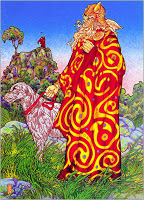
The charge of colourfulness against "things Celtic" might also have something to do with the modern romancing of Celticity and the false preconceived ideas this provides for the readers of Celtic legends. Tolkien's comment on Pwyll and the bright colours of the story is followed by the comment: "Can he have been a 'Celt'? He had never heard of the word, we may feel sure; but he spoke and wrote with skill what we now classify as a Celtic language: Cymraeg, which we call Welsh" (Tolkien 1983a, 173). Indeed, in the same part of the essay Tolkien referred to the "Celts" and the "Teutons," and the "romantic misapplication" of these terms, according to the "modern myth." He describes this myth with characteristic humour, but also with contempt:
In this legend Celts and Teutons are primeval and immutable
creatures, like a triceratops and a stegosaurus ... fixed not only
in shape but in innate and mutual hostility, and endowed even in
the mists of antiquity, as ever since, with the peculiarities of
mind and temper which can be still observed in the Irish or the
Welsh on the one hand and the English on the other: the wild
incalculable poetic Celt, full of vague and misty imaginations, and
the Saxon, solid and practical when not under the influence of beer
(Tolkien 1983a, 171-2).
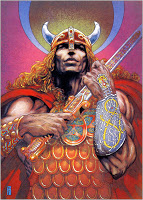
This myth goes back to the creation of such stereotypes in the nineteenth century; stereotypes that also encompassed racial characteristics, mainly initiated by Ernest Renan and Mathew Arnold who established the image of the visionary Celt and the practical Saxon (Sims-Williams 1986). Indeed, Tolkien himself had used such stereotypes much earlier. In his 1936 lecture "Beowulf: The Monsters and the Critics," he referred to "the English temper in its strong sense of tradition ... strengthened ... by the more inquisitive and less severe Celtic learning" (Tolkien 1983a, 23-4). In "English and Welsh," however, Tolkien goes on to talk about how such preconceptions affect ideas about what "Celtic" literature should be like. He claims that Beowulf sounds much more "Celtic" since it is "full of dark and twilight, and laden with sorrow and regret" than any original Celtic material. It is at this point that Tolkien uses the description of Arawn, the King of the Underworld in the Welsh "Mabinogion," to pinpoint the sharp contrast of the actual description of Arawn and his dogs as opposed to their romanticised "Celtic" portrayal, which would need to be "ominous, colourless, with the wind blowing, and a woma in the distance, as the half-seen hounds came baying in the gloom, huge shadows pursuing shadows to the brink of a bottomless pool" (Tolkien 1983a, 172). This is indeed a picture that clashes vigorously with the white red-eared dogs of Arawn. Tolkien makes his argument about the popular misconception of the term "Celtic" even more poignant by explaining that: "To many, perhaps to most people outside the small company of the great scholars, past and present, 'Celtic' of any sort is ... a magic bag, into which anything may be put, and out of which almost anything may come" (Tolkien 1983a, 185-6). In his letter to Milton Waldman, in which he referred to his project to create "a mythology for England," he talks of his desire for his own mythology to possess "the fair elusive beauty that some call Celtic (though it is rarely found in genuine ancient Celtic things)" (Carpenter 1981, 144)--and it is here, I think, quite clear that he refers exactly to the romantic idea of "Celticness," with its supposedly sorrowful tone and twilight setting, that he knows to be misleading.
Epilogue: "British at Heart"
Tolkien's fascination with "things Celtic" is not exhausted in the examples used in this article. His continuous interest in the Arthurian legend [11] has been discussed by Flieger, who has also referred to the use of such Arthurian place names in Tolkien's legendarium as Avalon and Broceliande (Flieger 2000, 57). There are also numerous smaller references and motifs that point to Celtic sources--such as the idea of the fighting trees in Kat Godeu ("The Army of Trees") found in "The Book of Taliesin," which might have something to do with the creation of the Ents and the Huorns, or the occasional mentioning of triads used in the same formulaic way as in the Trioedd ynys Prydein. This article concentrates on one major example in Tolkien's legendarium that originated in "things Celtic" that defined Tolkien's conception of his own mythology.
This incorporation of Celtic elements into a mythology that was initially intended to be purely "English" shows that Tolkien's views gradually changed. He eventually came to regard the Celts not as binary opposites to the Anglo-Saxons, but as co-invaders and co-inhabitants of the same island, of the same land about which he felt so passionately. This can be clearly seen in his essay "English and Welsh" where he not only rejects all the romantic notions of the stereotypical depictions of Celts and Anglo-Saxons, but also declares his admiration for the Welsh language as an essential part of Britain's past and soul. It is characteristic that in The Lord of the Rings, inherent to the conception of the Shire, the land of the hobbits--which Tolkien often equated with England--is the existence in its margins of the "queer" folk of Buckland, who are given Celtic first names and place names (Tolkien 1993b, 526). This change in Tolkien's attitude cannot be more clearly shown than in his own words regarding the Welsh language, which demonstrate the eventual modification of his reactions to "things Celtic." He says:
For many of us it [i.e. Welsh] rings a bell, or rather it stirs
deep harp-strings in our linguistic nature. In other words: for
satisfaction and therefore for delight ... we are still 'British'
at heart. It is the native language to which in unexplored desire
we would still go home (Tolkien 1983a, 194).
Biographical Note
Dimitra Fimi has recently completed a PhD at Cardiff University on J. R. R. Tolkien's creative uses of his scholarly knowledge in the creation of his Middle-earth fiction. She is also teaching a course on Tolkien for the Centre for Lifelong Learning at Cardiff University.
References Cited
Beddoe, Stella. "Fairy Writings and Writers." In Victorian Fairy Painting, ed. Jane Martineau. 23-31. London: Merrel Holberton Publishers, 1997.
Bown, Nicola. Fairies in Nineteenth-Century Art and Literature. Cambridge: Cambridge University Press, 2001.
Carpenter, Humphrey. Tolkien: A Biography. London: Allen and Unwin, 1977.
--. The Letters of J.R.R. Tolkien: A Selection. London: Allen and Unwin, 1981. Chesterton, Gilbert K. Orthodoxy. London: John Lane Company, 1908.
Colley, L. Britons: Forging the Nation, 1707-1837. New Haven, Conn.: Yale University Press, 1992.
Croker, Thomas Crofton. Fairy Legends and Traditions of the South of Ireland. 3 Parts. London: John Murray, 1825-8.
Cross, Tom Peete, and Clark Harris Slover, eds. and trans. Ancient Irish Tales. Dublin: Allen Figgis, 1969.
Davies, Sioned. Crefft y Cyfarwydd: Astudiaeth o Dechnegau Naratif yn Y Mabinogion. Caerdydd: Gwasg Prifysgol Cymru, 1995.
--. "Written Texts as Performance: The Implications for Middle Welsh Prose Narratives." In Literacy in Medieval Celtic Societies, ed. Huw Pryce. 133-48. Cambridge: Cambridge University Press, 1998.
Drout, Michael D. C. "A Mythology for Anglo-Saxon England." In J. R. R. Tolkien and the Invention of Myth: A Reader, ed. Jane Chance. 335-62. Lexington, Ky. University Press of Kentucky, 2004.
Flieger, Verlyn. "J. R.R. Tolkien and the Matter of Britain." Mythlore 23 (2000): 47-59.
Garth, John. Tolkien and the Great War: The Threshold of Middle-earth. London: HarperCollins, 2003.
Gunnell, Terry. "Tivar in a Timeless Land: Tolkien's Elves." Paper presented at the Conference on Tolkien, Laxness, Undset: A Symposium, Reykjavik, Iceland September 2002. Available from
http://www.nordals.hi.is/Apps/WebObjects/HI.woa/wa/dp?detail=1004509&name;= nordals_en_greinar_og_erindi; INTERNET.
Horsman, R. "Origins of Racial Anglo-Saxonism in Great Britain before 1850." Journal of the History of Ideas 37, no. 3 (1976): 387-410.
Kumar, K. The Making of English National Identity. Cambridge: Cambridge University Press, 2003.
Macalister, R. R. Stewart, ed. and trans. Lebor Gabala Erenn: The Book of the Taking of Ireland, Part IV, Irish Texts Society. vol. 41. Dublin: Irish Texts Society, 1941.
Advertisement
Melman, B. "Claiming the Nation's Past: The Invention of an Anglo-Saxon Tradition." Journal of Contemporary History 26, nos. 3/4 (1991): 575-95.
Morris-Jones, John. A Welsh Grammar: Historical and Comparative. Oxford: Clarendon Press, 1913. O hOgain, Daithi. Myth, Legend and Romance: An Encyclopaedia of the Irish Folk Tradition. London: Ryan, 1990.
Purkiss, Diane. Troublesome Things: A History of Fairies and Fairy Stories. London: The Penguin Press, 2000.
Shippey, Tom. J. R. R. Tolkien: Author of the Century. London: HarperCollins, 2001.
--. "Tolkien and Iceland: the Philology of Envy." Paper presented at the Conference on Tolkien, Laxness, Undset: A Symposium, Reykjavik, Iceland September 2002. Available from
http://www.nordals.hi.is/Apps/WebObjects/HI.woa/wa/dp?detail=1004508&name;= nordals_en_greinar_og_erindi; INTERNET.
Sims-Williams, Patrick. "The Visionary Celt: The Construction of an 'Ethnic Preconception'." Cambridge Medieval Celtic Studies 11 (1986): 71-96.
--. "Celtomania and Celtoscepticism." Cambrian Medieval Celtic Studies 36 (1998): 1-36. Stokes, Whitley, ed. and trans. Togail Bruidne Da Derga: The Destruction of Da Derga's Hostel. Paris: Emile Bouillon, 1902.
Stenstrom, Anders. "A Mythology? For England?" In Proceedings of the J. R. R. Tolkien Centenary Conference, 1992: Proceedings of the Conference Held at Keble College, Oxford, England, 17th-24th August 1992 to Celebrate the Centenary of the Birth of Professor J.R.R. Tolkien, Incorporating the 23rd Mythopoeic Conference (Mythcon XXIII) and Oxonmoot 1992, ed. Patricia Reynolds and Glen GoodKnight. 310-4. Milton Keynes: Tolkien Society, 1996.
Tolkien, J. R. R. "Appendix I: The Name 'Nodens'." In Report on the Excavation of the Prehistoric, Roman, and Post-Roman Site in Lydney Park, Gloucestershire, ed. R. E. M. Wheeler. 132-7. Oxford: Printed at the University Press for The Society of Antiquaries, 1932.
--. "The Lay of Aotrou and Itroun." The Welsh Review 4, no. 4 (1945): 254-66.
--. "J. R. R. Tolkien Interviewed for BBC Radio." Interview by Denys Gueroult, 20 January 1965.
--. "Guide to the Names in The Lord of the Rings." Revised for publication by Christopher Tolkien. In A Tolkien Compass, ed. Jared Lobdell. 153-201. La Salle, Ill.: Open Court, 1975.
--. The Silmarillion, ed. Christopher Tolkien. London: Allen and Unwin, 1977.
--. The Monsters and the Critics and Other Essays, ed. Christopher Tolkien. London: Allen and Unwin, 1983a.
--. The Book of Lost Tales: Part Led. Christopher Tolkien. London: HarperCollins, 1983b.
--. The Book of Lost Tales: Part II, ed. Christopher Tolkien. London: HarperCollins, 1984.
--. The Lays of Beleriand, ed. Christopher Tolkien. London: HarperCollins, 1985.
--. The Shaping of Middle-earth, ed. Christopher Tolkien. London: HarperCollins, 1986.
--. The Lost Road and Other Writings, ed. Christopher Tolkien. London: HarperCollins, 1987.
Advertisement
--. Sauron Defeated, ed. Christopher Tolkien. London: HarperCollins, 1992.
--. The Lord of the Rings, Volume I: "The Fellowship of the Ring." pbk ed. London: HarperCollins, 1993a. First published Allen and Unwin, 1954.
--. The Lord of the Rings, Volume III: "The Return of the King." pbk ed. London: HarperCollins, 1993b. First published Allen and Unwin, 1955.
--. Morgoth's Ring, ed. Christopher Tolkien. London: HarperCollins, 1993c.
--. The War of the Jewels, ed. Christopher Tolkien. London: HarperCollins, 1994.
Tolkien, J. R. R., and E. V. Gordon, eds. Sir Gawain and the Green Knight. Oxford: Clarendon Press, 1925.
Tyler, J. E. A. The Complete Tolkien Companion. London: Pan Books, 1976.
Wood, Juliette. "Colour in the Mabinogion Tales." In Colour and Appearance in Folklore, eds. John Hutchings, and Juliette Wood. 16-21. London: The Folklore Society, 1991.
Yeats, W. B., ed. Fairy and Folk Tales of the Irish Peasantry. London: Walter Scott, 1888.
--. Irish Folk Stories and Fairy Tales. New York: Grosset & Dunlap, 1957.
Notes
[1] Parts of this article have been presented as papers at the 40th International Congress on Medieval Studies, Western Michigan University, Kalamazoo, MI, 5-8 May 2005, and at the Celtic Folk Studies Conference, Cardiff University, 20-23 July 2005. The author is grateful for the comments received on both occasions.
[2] Previous Tolkien scholarship has established the convention of using "The Silmarillion" within quotation marks to refer to the body of stories and poems that Tolkien developed over many years, and The Silmarillion in italics to refer to the published volume of 1977. Also, in order to maintain consistency in terms of spelling for the Irish names, I have followed O hOgain (1990) (except for quotations, where the spelling of the original is respected), while for Tolkien's nomenclature I have preferred to adhere to Tolkien's own spelling in the different stages of his "legendarium" to which I am referring.
[3] For more of Tolkien's declarations about his appreciation of Welsh, see also Tolkien (1983a, 162 and 189-94) and Carpenter (1981, 213, 218-19 and 289).
[4] It has been decidedly proven that Tolkien never used the exact words "a mythology for England." This phrase was introduced by Tolkien's biographer, Humphrey Carpenter (1977, 89; see Stenstrom 1996), but it has been used since as a standard term to refer to his early nationalistic project. The only time Tolkien came very close to this phrase was when he wrote to a reader that he felt he had set himself a task "to restore to the English an epic tradition and present them with a mythology of their own" (Carpenter 1981, 230-1).
[5] Since the 1980s, the heated debate about whether there existed a homogeneous "Celtic" people in Britain prior to the Anglo-Saxon "migration" or "invasion" has also challenged the validity of the designations "Celt" and "Celtic" as meaningful and authentic terms for an ethnic or cultural group. In this article, the term "Celtic" has been used in its older sense, prior to these developments, since this is how Tolkien and his contemporaries would have understood it. For an overview of the arguments and counter-arguments of the recent debate about the use of "Celt" as a valid ethno-cultural designation, see Sims-Williams (1998).
[6] For a detailed analysis of the Anglo-Saxon elements in Tolkien's mythology, including the presence of the legendary leaders of the adventus Saxonum, Hengest and Horsa, in his earliest drafts, see Drout (2004).
Advertisement
[7] Apart from his mistakes, Tyler also chose to adopt a fanciful, make-believe approach to Tolkien's work, quite common in fan publications. Many authors of popular criticism on Tolkien have often pretended to take at face value Tolkien's literary device of presenting his work as translations from a very old manuscript he had supposedly found (see, for example, Tolkien 1993b, 522-30). Instead of tracing influences of extant mythologies on Tolkien's literature, such authors chose to adopt a kind of reverse reality, interpreting well-known characters and folklore motifs from extant mythologies as survivals of the long forgotten legend supposedly "re-discovered" and "translated" by Tolkien. Tyler, then, explained the similarities of the Tuatha De Danann with the Noldor as dim memories of the latter by the Irish, many years after the departure of the Elves (1976, 179). In my view, the playful tone of this approach, through which often worthwhile information is presented, undermines any noteworthy insight any such scholar has to offer on Tolkien's fiction.
[8] The summary is based on Macalister (1941, 106-11, and 138-47), Cross and Slover (1969, 11-13, 22, and 28-9) and O hOgain (1990, 407-9).
[9] The story of the Noldor appears again in the "Quenta [Noldorinwa]" of c. 1930 (Tolkien 1986, 94, 96, 101 and 102), in the "Earliest Annals of Valinor" and "of Beleriand" of the early 1930s (Tolkien 1986, 266, 268, 269 and 295), in the "Later Annals of Valinor" and "of Beleriand" of the middle and later 1930s (Tolkien 1987, 115, 116-17, 118, 125 and 126), in the "Quenta Silmarillion" of the later 1930s (Tolkien 1987, 234, 237-8, 248-9, 250 and 252), and in the "Annals of Aman," the "Later Quenta Silmarillion" and the "Grey Annals" of the early 1950s (Tolkien 1993c, 111-12, 127 and 196; 1994, 16-18, 29-30 and 31-2).
[10] In later Celtic folklore the characters described as having green hair are usually the Merrows (Croker, 1828, Part II, 34; Yeats 1888, 61 and 64), but there is also one example of a medieval Irish-language tale, the twelfth-century Togail Bruidne Da Derga "The Destruction of Da Derga's Hostel'--where a boy is described as having "three kinds of hair," namely "green hair and purple hair and all-golden hair" (Stokes 1902, 103).
[11] Note also that there is a discussion between the members of the "Notion Club" in Tolkien's unfinished work "The Notion Club Papers" on the historicity of Arthur, and on the fictional discovery of a new manuscript in medieval Welsh that would provide more reliable historical information on him (Tolkien 1992, 192, 216 and 227-9).
Advertisement
COPYRIGHT 2006 Folklore Society
COPYRIGHT 2006 Gale Group


 ( eu suspeito que o artista aí dessa picture fez esse Balor inspirado na fisionomia de Tolkien meio que pra dar a indireta de que
( eu suspeito que o artista aí dessa picture fez esse Balor inspirado na fisionomia de Tolkien meio que pra dar a indireta de que 